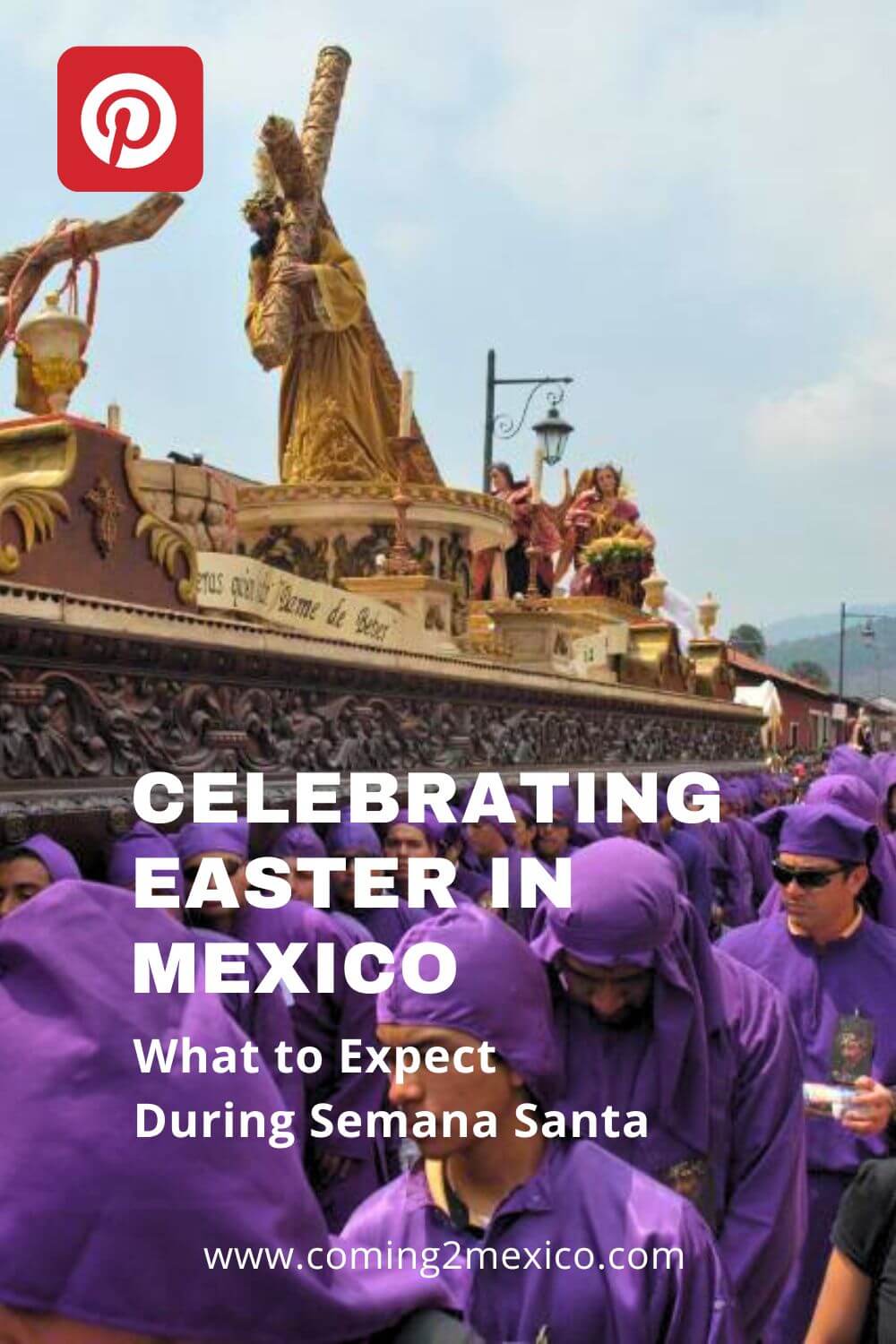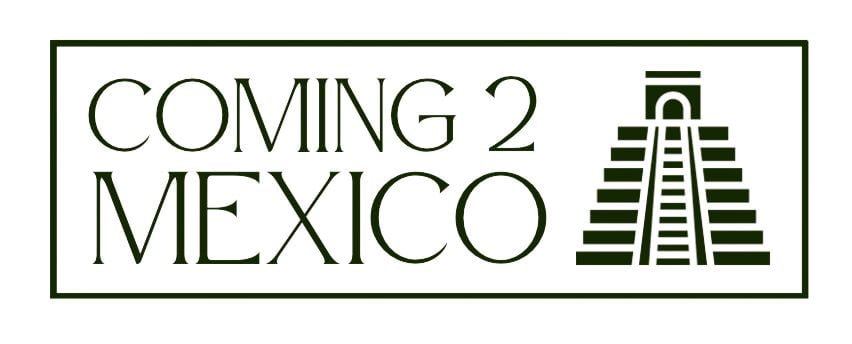Contents
- Easter in Mexico – Events and Celebrations You Won’t Want to Miss
- Important Dates Leading up to Easter in Mexico
- Carnival (Carnaval)
- Miércoles de Ceniza (Ash Wednesday)
- Cuaresma (Lent)
- Día Samaritana (Samaritan Day)
- Viernes de Dolores (Friday of Sorrows)
- Semana Santa – Mexico’s Holy Week
- Domingo de Ramos (Palm Sunday)
- Lunes Santo (Holy Monday)
- Miercoles Santo (Holy Wednesday)
- Jueves Santo (Holy Thursday or Maundy Thursday)
- Viernes Santo (Good Friday)
- Sabado Santo or Sabado de Gloria (Holy Saturday)
- Domingo de Resurrección or Domingo de Pascua (Easter Sunday)
- Semana Pascua (Easter Week)
- Interesting Easter Traditions and Customs in Mexico
- The Best Places to Celebrate Easter in Mexico
- Traditional Easter Foods in Mexico
- Traveling in Mexico During the Easter Season
- Related Articles
- Did you enjoy this article? Share it with a friend!
Easter in Mexico – Events and Celebrations You Won’t Want to Miss
Easter in Mexico is a two-week celebration filled with a mix of Catholic tradition, indigenous practices, and modern celebration. It is one of the most important holidays in Mexico and across Latin America.
Easter is when Mexicans travel to be with their families, and it’s also the most popular time of year for family excursions. All the schools are out of session for two weeks. Most people try to arrange for time off and flock to Mexico’s beaches, or take vacations abroad.
Having lived and explored Mexico for two decades, I’ve witnessed firsthand the depth of these traditions. From the solemn processions of Semana Santa to the joyous festivities of Domingo de Resurrección, Easter here is a profound reflection of Mexico’s cultural heritage and religious devotion.

If you are traveling with kids, keep in mind, the focus here leans more toward spiritual observance and community rather than Easter egg hunts and chocolate bunnies. But that doesn’t mean your family won’t have a wonderful time celebrating Easter in Mexico.
Read on to discover what makes the Easter season so special and the Mexican towns and cities where you can find the most authentic experience.
Important Dates Leading up to Easter in Mexico
A vibrant prelude to Lent, Carnival is celebrated with parades, costumes, and dancing. It’s a time of joy and indulgence before the solemnity of Lent. Celebrated with fervor, particularly in the cities of Mazatlán, Veracruz, Merida and San Miguel de Cozumel, Carnival here in Mexico is a spectacle of parades, music, and dance, a joyous indulgent prelude to Lent’s solemnity.
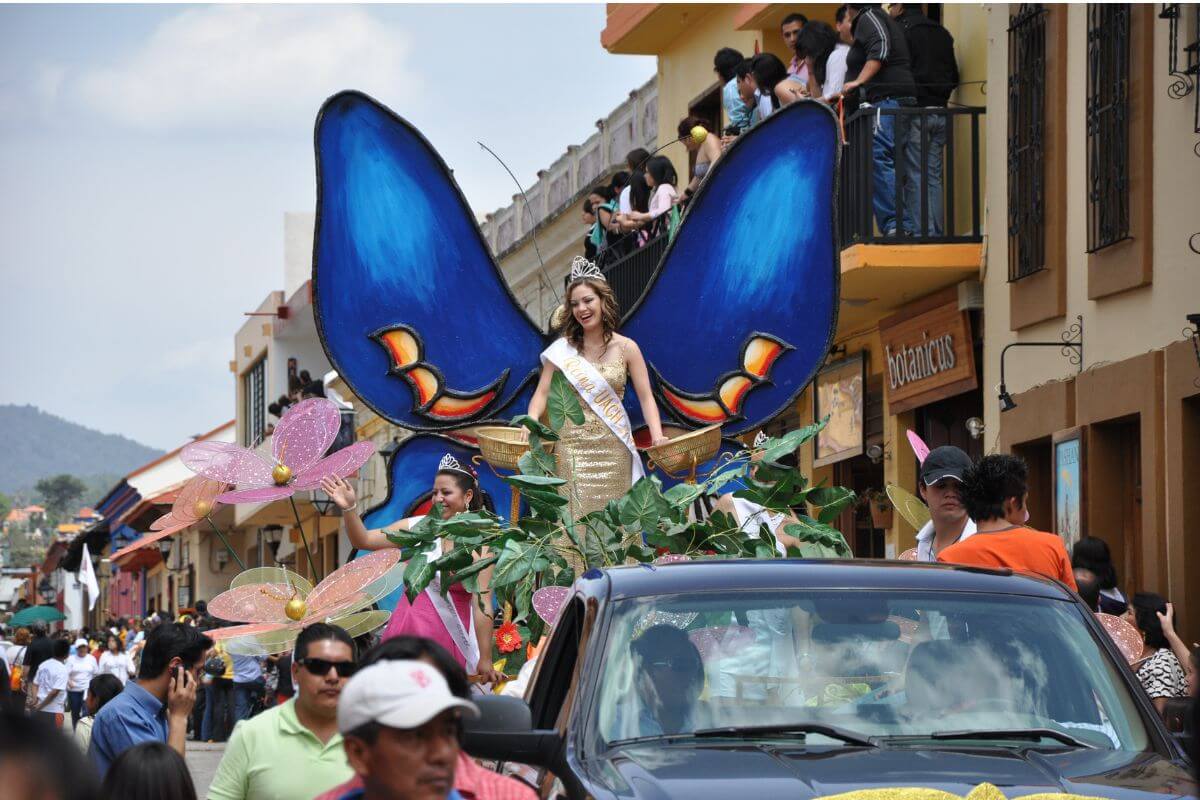
Miércoles de Ceniza (Ash Wednesday)
This marks the beginning of Lent, where ashes are placed on foreheads in the shape of a cross, symbolizing mortality and repentance. This day sees churches across Mexico, from the urban centers of Mexico City to the rural chapels of Chiapas, filling with believers receiving ashes.
Cuaresma (Lent)
The 40 days following Ash Wednesday, a period of reflection and preparation for Easter. Many abstain from eating meat on Fridays, opting for seafood or vegetarian dishes instead. The devout may eschew red meat throughout the Lenten season. Popular dishes in Mexican homes during Lent include bacalao, chiles rellenos and empanadas de vigilia.
Día Samaritana (Samaritan Day)
A unique tradition where refreshing beverages are given out to remind of the Samaritan woman who offered water to Jesus. It’s a day of sharing and community. Oaxaca is particularly known for its Samaritan Day celebrations, where locals offer aguas frescas to passersby, echoing the Samaritan woman’s act of kindness.
Viernes de Dolores (Friday of Sorrows)
This day honors the Virgin Mary’s pain over the crucifixion of Jesus. Altars are beautifully decorated in homes and churches, with offerings to express sympathy and reverence. Guanajuato vividly observes this day, with altars and offerings to the Virgin Mary in homes and public spaces, creating a city-wide homage.
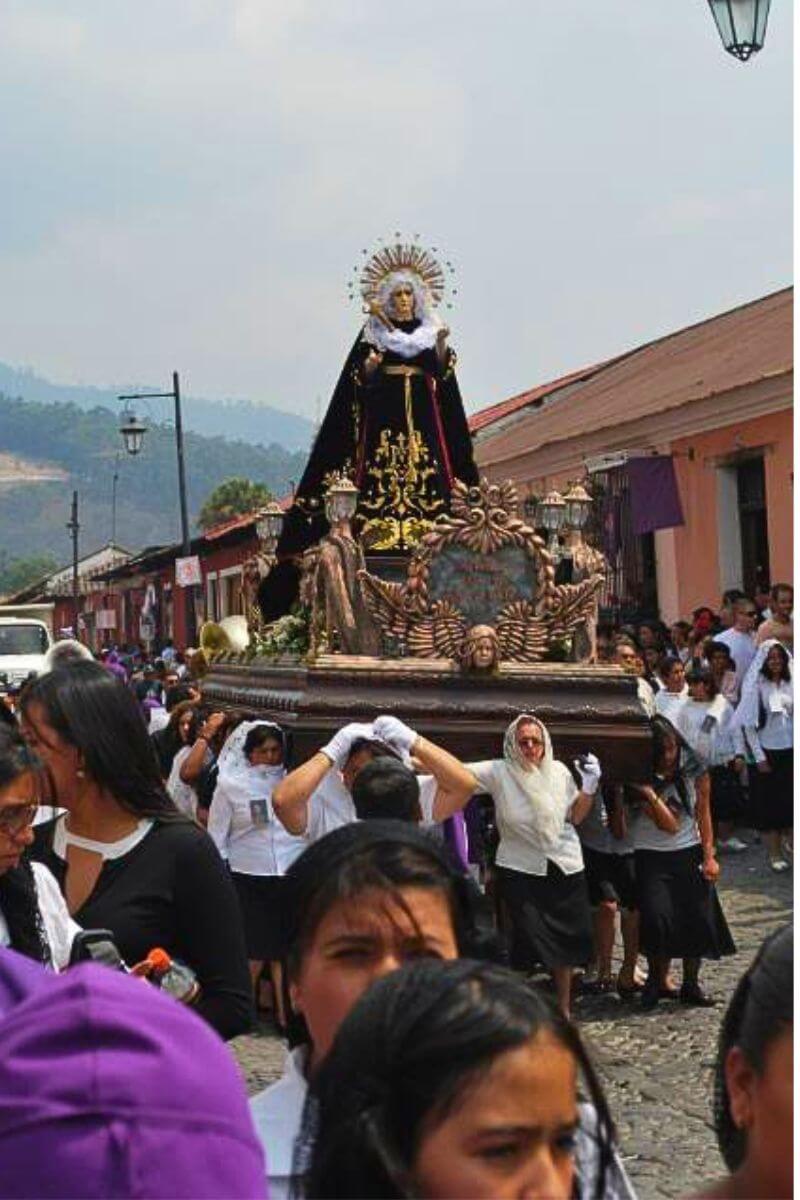
Semana Santa – Mexico’s Holy Week
Holy Week in Mexico is a week-long celebration that includes religious processions, passion plays, special masses and church services. This is the first week of the Easter season and is a deeply spiritual time, with activities from Palm Sunday through Easter Sunday reflecting the final days of Jesus’s life. In colonial cities throughout Mexico, the processions and rituals of Semana Santa are dramatic and moving, with flagellants and hooded penitents filling the cobblestone streets.
Let’s take a look at the Easter celebrations you are likely to experience if you are traveling in Mexico during the Holy Week.
Domingo de Ramos (Palm Sunday)
Commemorates Jesus’s entry into Jerusalem. Mexicans attend mass, carrying palm fronds to be blessed. Street vendors will often sell palm leaves, folded and braided, into various shapes and figures signifying victory and peace. The devout will have their palms blessed and hang them above their doorway to ward off evil. The town of San Cristóbal de las Casas in Chiapas offers a unique blend of indigenous and Spanish traditions for Palm Sunday observances. Every year, townspeople reenact the triumphant arrival of Jesus into Jerusalem on a donkey laying palm branches in his path.

Lunes Santo (Holy Monday)
According to the traditional timeline, Holy Monday is the day Jesus went to the temple and found it filled with vendors. He chased the vendors away, proclaiming that the temple is a sacred place that must be respected. Religious observances begin to intensify, with some regions participating in unique local customs that reflect on the events leading up to Jesus’s crucifixion. While more subdued, regions with strong indigenous communities, such as the Zapotec in Oaxaca, observe this day with ancient traditions that blend Spanish influence with ancient prehispanic rituals.
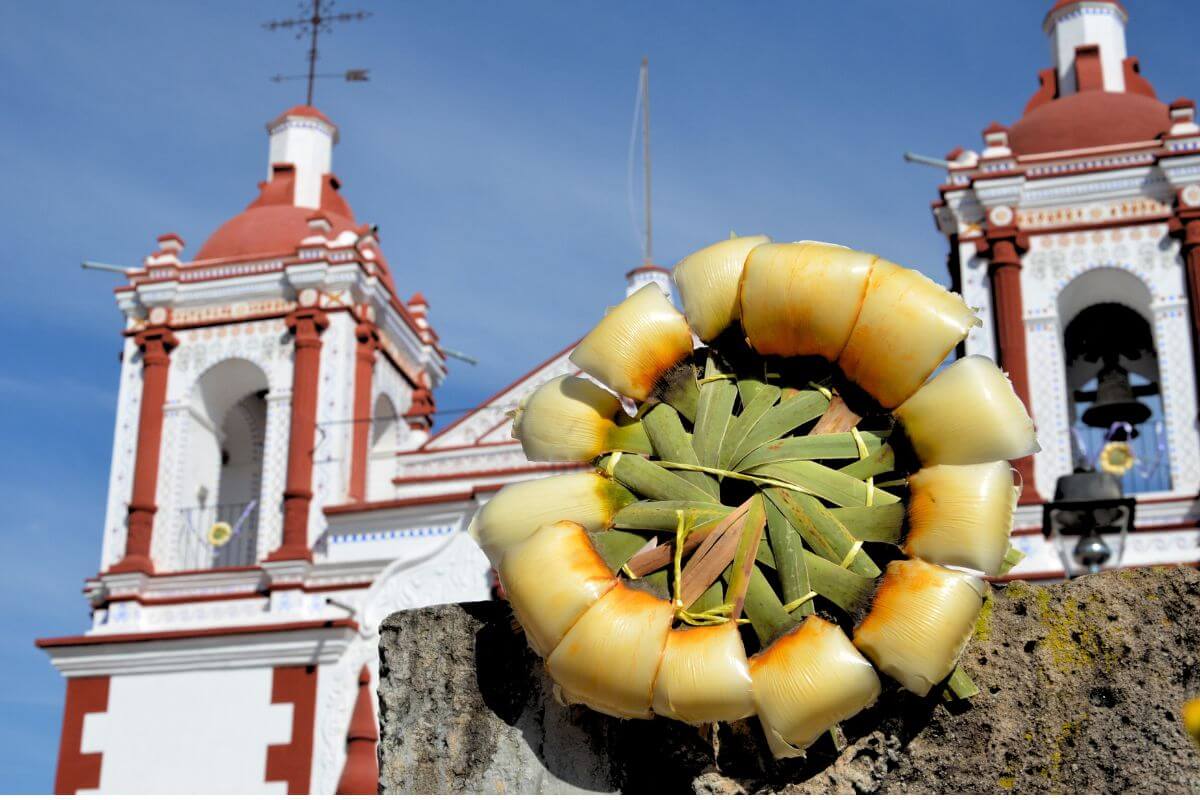
Miercoles Santo (Holy Wednesday)
Sometimes known as Spy Wednesday, certain Mexican towns and cities will hold silent processions or special masses called Los Matines de la Tinieblas highlighting Jesus’s betrayal, emphasizing reflection and penitence.
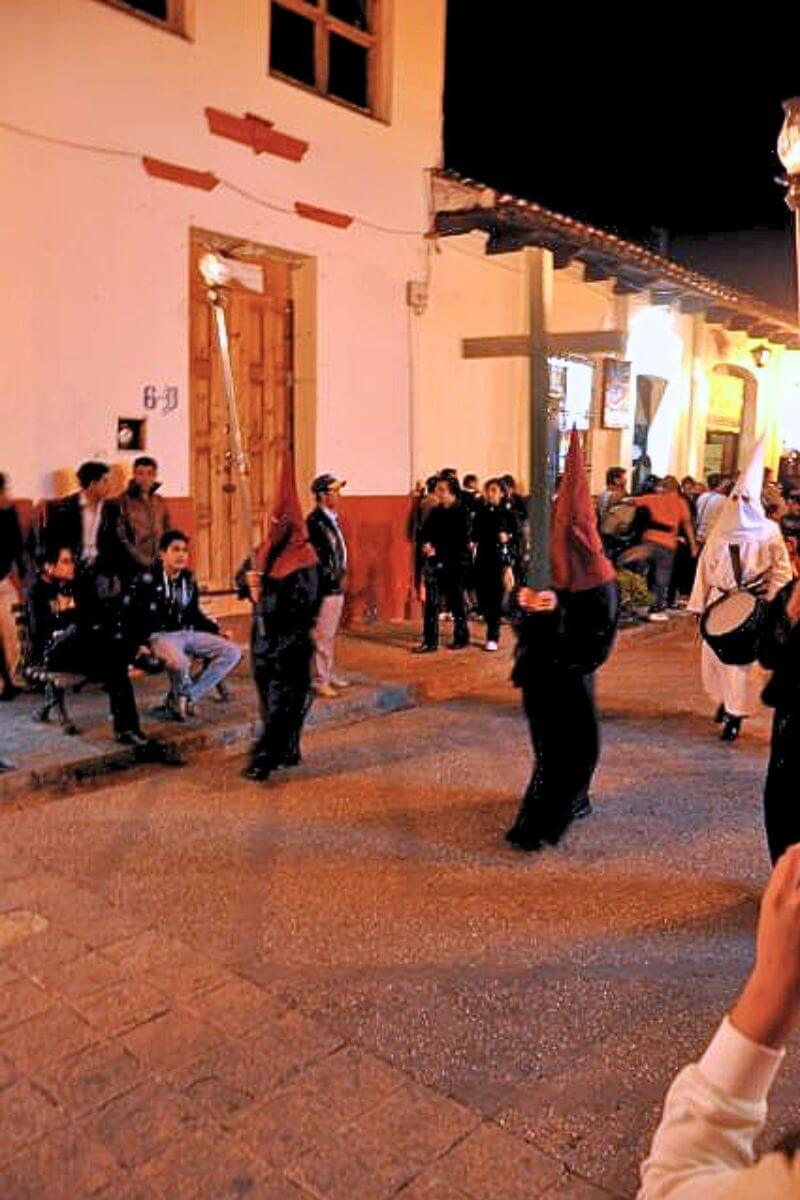
Jueves Santo (Holy Thursday or Maundy Thursday)
Thursday of Holy Week recalls the Last Supper that Jesus shares with his disciples and the institution of the eucharist (holy communion), his betrayal by his disciple Judas Iscariot, and his arrest at the Garden of Gethsemane.
On Holy Thursday, the devout will participate in the Visita de Siete Casas, the ancient tradition of visiting seven churches, chapels or convents to pray before the altars of repose. On this day when the faithful symbolically accompany Jesus of Nazareth during his journey towards his death.
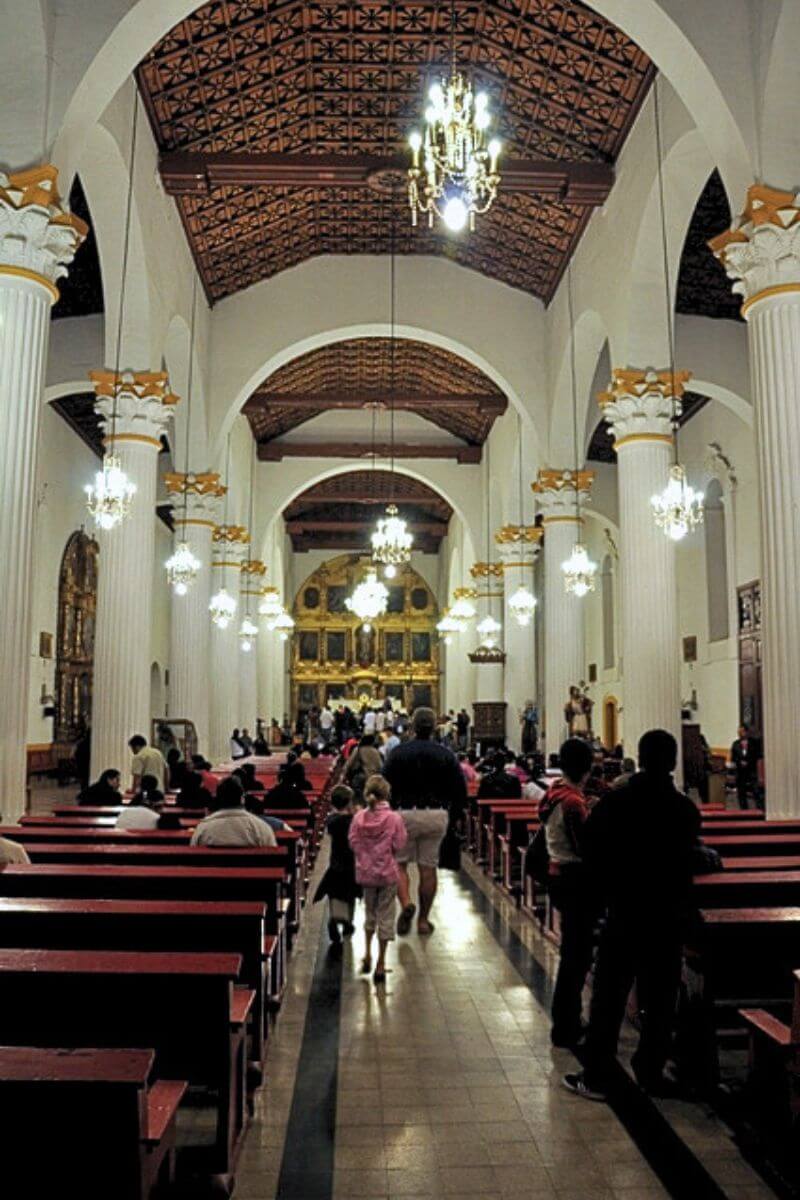
Viernes Santo (Good Friday)
The most solemn day, marked by elaborate processions and reenactments of the Via Crucis (Way of the Cross). On this day, you’ll find the reenactment of Christ’s crucifixion and processions with the Virgin Mary. Iztapalapa, in Mexico City, hosts one of the most renowned passion plays, drawing thousands to witness the reenactment of the crucifixion of Christ.
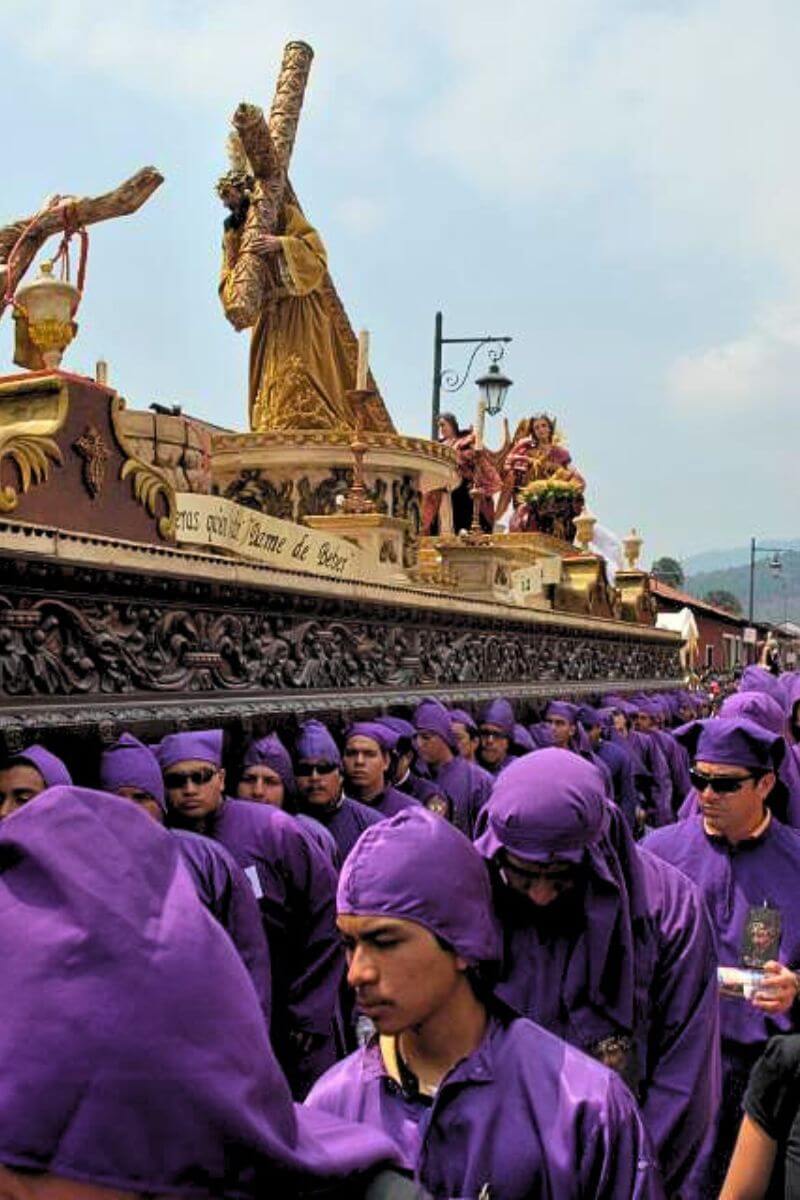
Sabado Santo or Sabado de Gloria (Holy Saturday)
Sabado Santo marks the time in between Christ’s death and his resurrection. Traditionally, this is a day of reflection on Jesus’s burial and the silence of the tomb. The burning of Judas effigies on Holy Saturday is a popular spectacle in many towns. The figures, crafted of paper maché in the likeness of Judas, Satan, and even contemporary political figures, are marched through the streets to the town squares and then burned or blown up with fireworks. The burning of the Judases symbolizes the conquest of good over evil.
Domingo de Resurrección or Domingo de Pascua (Easter Sunday)
A joyous celebration of the resurrection of Jesus Christ before he ascended into Heaven. Churches will be filled with parishioners celebrating the rise of Christ. Church bells will ring throughout the cities and the plazas will be packed with joyous people.
In some cities, there are fabulous Easter parades with colorful floats and marching bands. In Mexico, this joyous day kicks off another week of celebration and relaxation with family.

Semana Pascua (Easter Week)
The second week of the Easter celebration is often a time for relaxation and vacation, as schools are out and many Mexican families take trips to enjoy the spring weather. This time of year is often considered Mexico’s spring break as many families take the opportunity to vacation, with beach destinations like Puerto Vallarta, Cancun and Playa del Carmen becoming popular spots for relaxation and celebration.
Interesting Easter Traditions and Customs in Mexico
Mexico’s Holy Week traditions are mostly based on those from Spain, brought over during the conquest of the Aztec Empire. Particular observances have evolved in different parts of the country blending colonial traditions with indigenous rituals.
Across Mexico, Via Crucis, dramatic reenactments of the Passion of Christ, are common. Most of the Holy Week celebrations in Mexico look nearly identical to those presented in Spain. However, there are a few Easter rituals that are unique to Mexico.
Via Crucis (Way of the Cross or Stations of the Cross)
Among the representative Holy Week traditions is the famous Via Crucis, or Way of the Cross. The fourteen Stations of the Cross mark historical points along the Via Dolorosa, the route Jesus took through the streets of Jerusalem from His condemnation to crucifixion.

Each one of the Stations signifies where a particular event took place. The Stations of the Cross are also commonly referred to as the Passion Play. This elaborate procession takes place each year in Mexico on Good Friday.
The Via Crucis is performed in over 350 cities and towns in Mexico. Some renact all 14 stations but many offer an abbreviated procession with 7 to 12 stations. The most famous Passion Play in Mexico is presented in Itzapalapa a suburb of Mexico City and involves the participation of 5000 local residents.
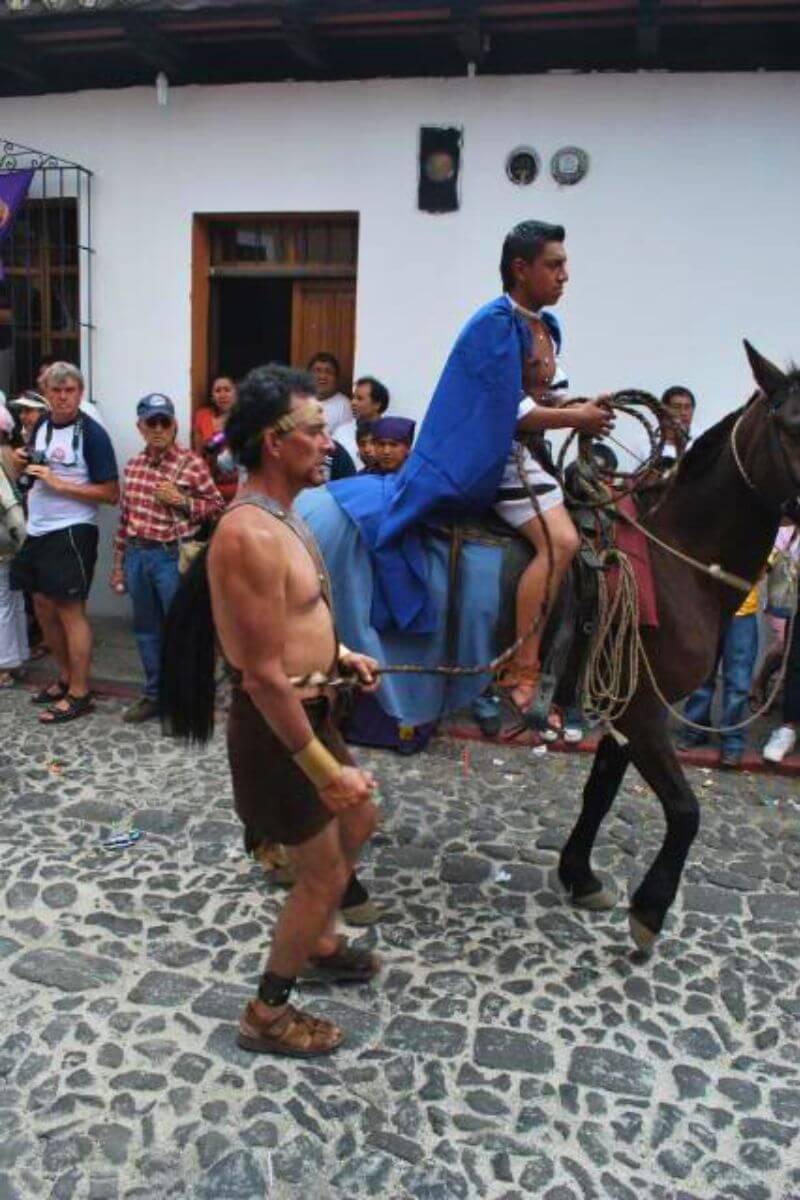
We have observed the Via Crucis in San Cristobal de las Casas, San Miguel de Allende, Oaxaca City and Antigua, Guatemala. Each representation was spectacular and emotional for everyone who was there to bear witness. Whether you are a believer or not, this celebration of faith should be on your Mexico bucket list.
Alfombras
During Semana Santa (Holy week) you will see Alfombras de Aserrin (sawdust rugs) displayed throughout the streets of many colonial cities including San Cristobal de las Casas, Chiapas, San Miguel de Allende, Guanajuato, Huamantla, Tlaxcala and Cholula, Puebla among many others. These intricately designed rugs are carefully created using layers of colored sawdust, flower petals, leaves and aromatics like chamomile. These mats are traditionally created to greet the religious processions that walk on them.
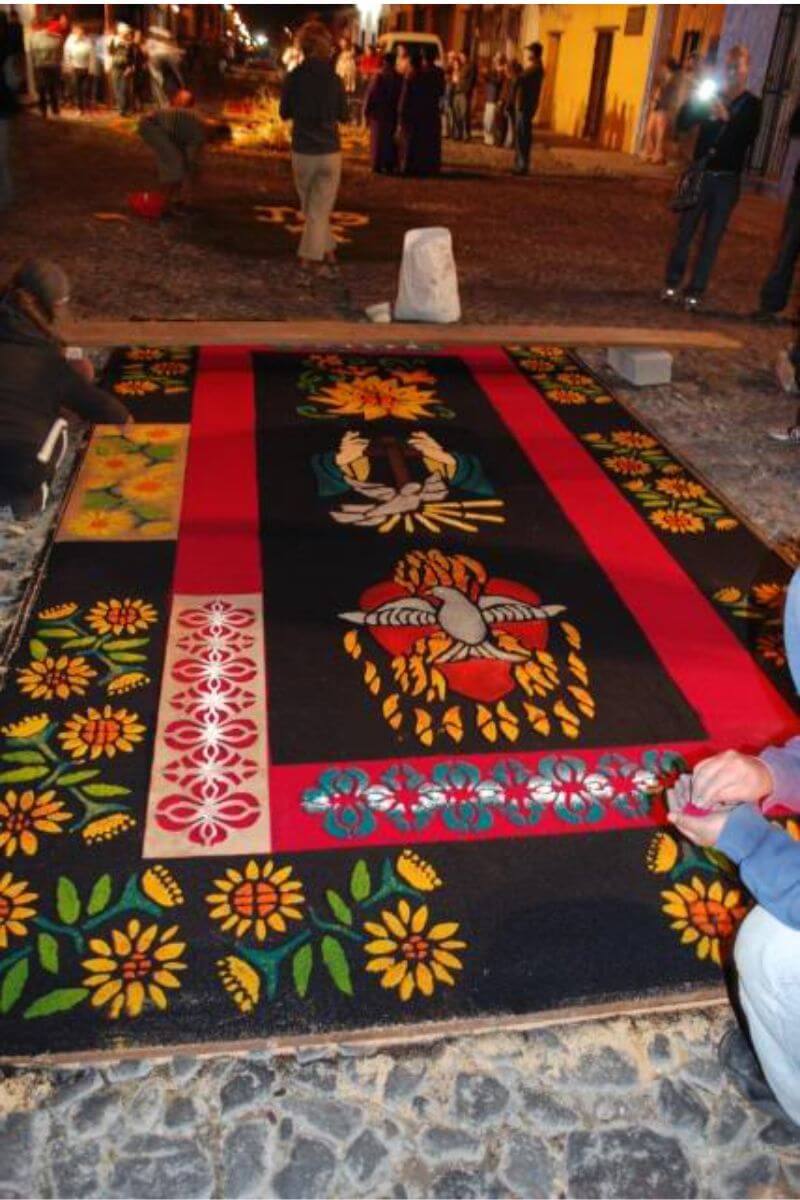
The tradition of decorating streets in this way began in Europe and was brought to the Americas by the Spanish. The tradition is still found in Mexico, Central America and parts of South America but in Cholula and San Miguel de Allende the alfombras are particularly spectacular. Work on the elaborate alfombras starts in the late afternoon. The work will carry on all night, with the finishing touches being put on as the processions begin in the morning. Once the processions have passed, the streets are cleaned.
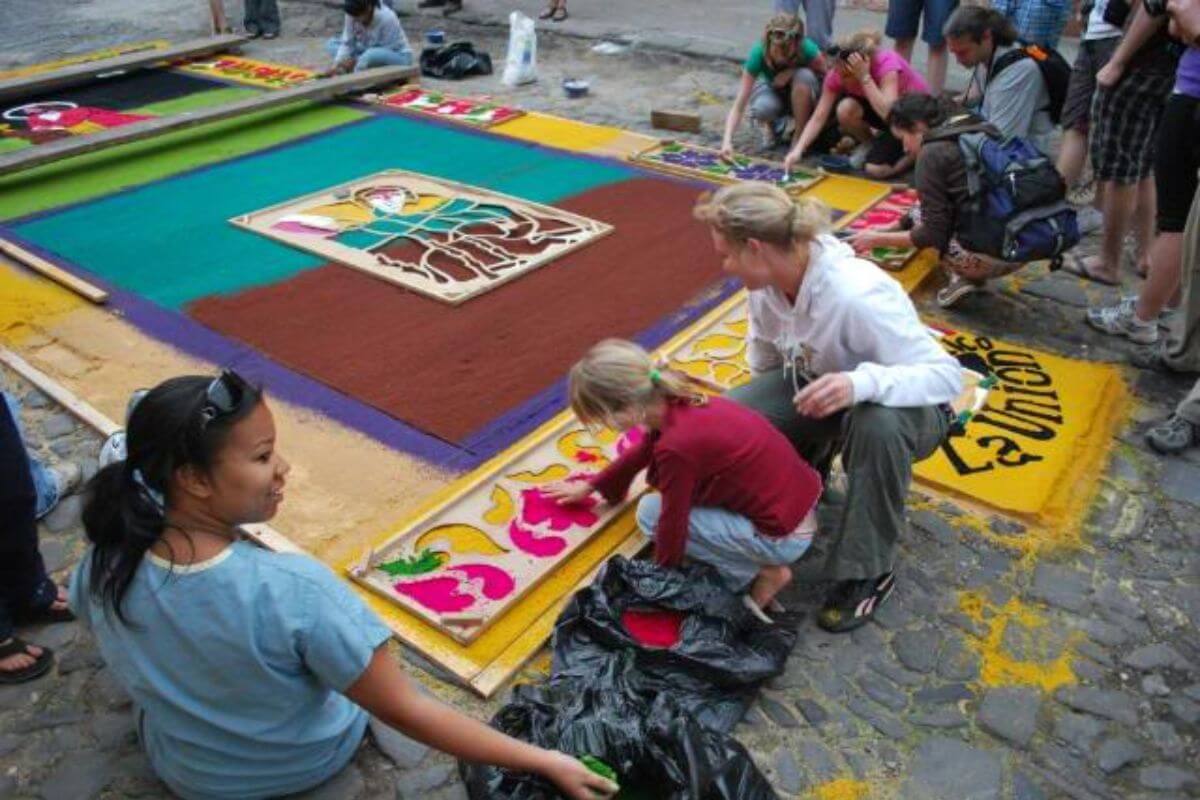
Los Matines de las Tinieblas (Vespers of Darkness)
Holy Wednesday recalls the abandonment of Jesus with Los Matines de las Tinieblas (Vespers of Darkness). In some parts of Mexico, there are special church services featuring a candelabra with 15 candles. A candle is extinguished for each Psalm sung until finally, a single candle remains, representing Christ alone in the garden.
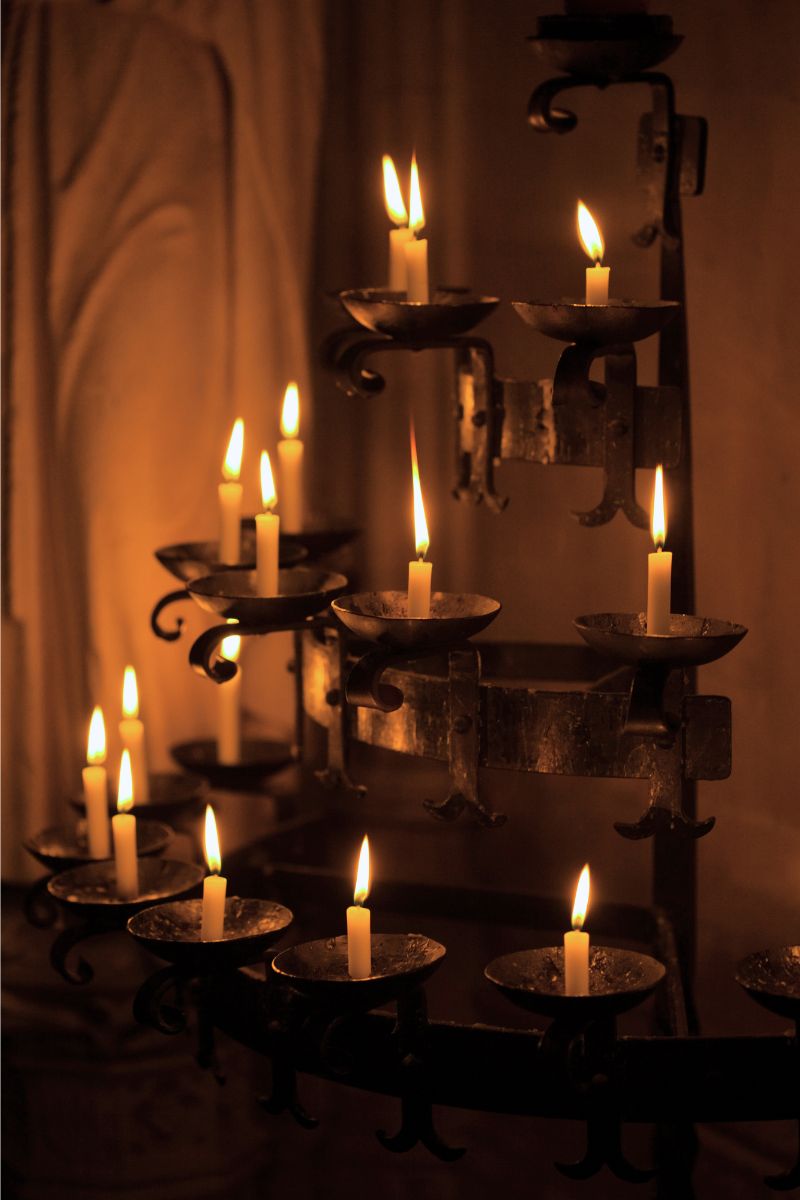
La Visita de las Siete Casas (Visitation of the 7 Churches)
La Visita de las Siete Casa is an ancient Roman Catholic tradition when the faithful visit the Altars of Repose of seven different churches on the evening of
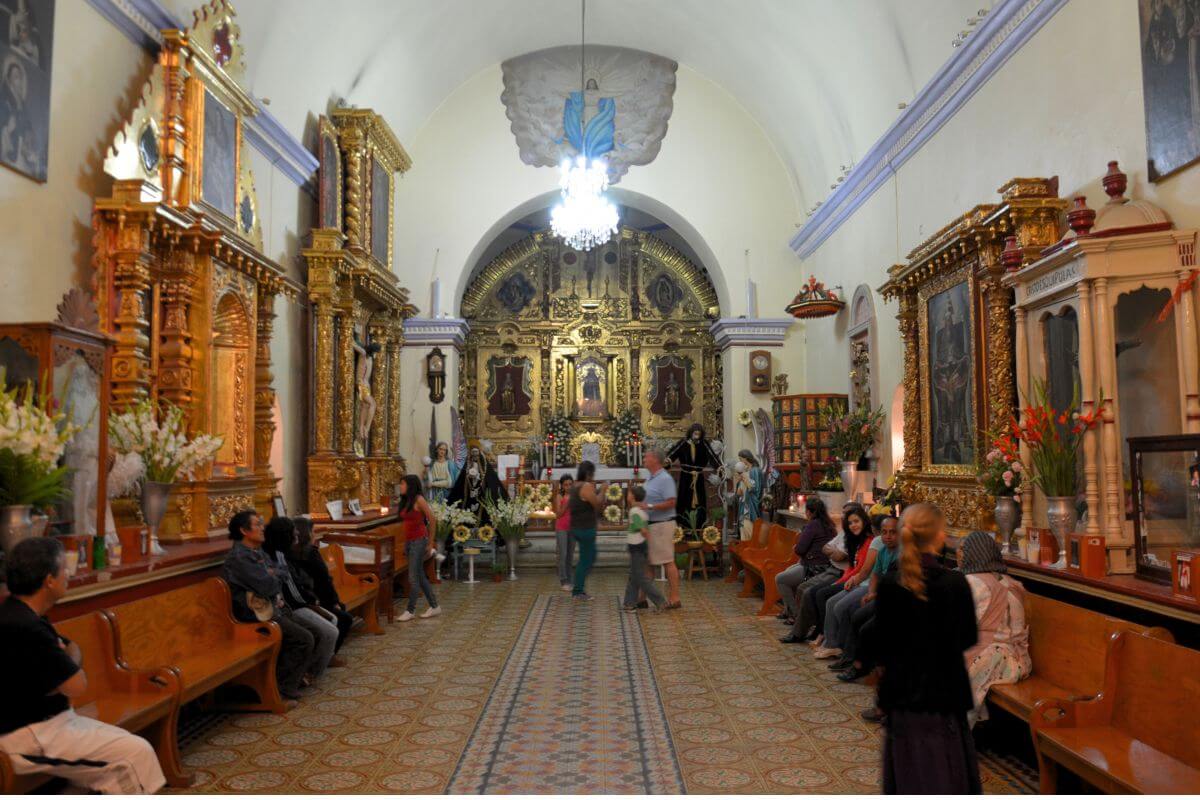
Maundy Thursday. The seven different churches correspond to each of the seven places, or “stations,” that were made by Jesus between the Last Supper and His crucifixion. In cities or neighborhoods with a large concentration on churches, La Visita de las Siete Casaa is a grand occasion.
El Quema de Judas (The Burning of Judas)
One of the Holy Week rituals unique to Mexico is the Burning of Judas. Local piñata artisans create effigies of Judas Iscariot, the disciple who betrayed Jesus. The effigies are made of cardboard and paper maché and fashioned to look like Judas. Unlike regular piñatas, they are not filled with candies and other sweets but rather loaded with firecrackers.
On the Saturday before Easter (Sabado Santo), the Judas effigies are burned or blown up in the public square creating a noisy and firey spectacle! Over the years, this practice has evolved to include the burning of other figures such as the devil and unpopular political figures.
You can witness the Burning of Judas in many colonial cities, especially in central and southern Mexico. We were lucky enough to catch this unusual “festival” during one of our trips to San Miguel de Allende.
Cascarones
While chocolate eggs and the Easter bunny may not make an appearance in the celebrations of Easter in Mexico, Easter eggs called cascarones are a popular secular tradition. Cascarones are hollowed-out eggshells, colorfully decorated and filled with bits of confetti.
The eggs are broken over people’s heads during festive celebrations like birthdays, Carnival and Easter. It’s all meant in good fun and the person who receives the egg is also supposed to be blessed with good luck. As you might expect, this tradition seems to be more popular in urban areas close to the border with the United States becoming less common the further south you travel.
The Best Places to Celebrate Easter in Mexico
I have lived in Mexico with my family for over 20 years. Because the two-week vacation surrounding Easter is one of the longest breaks we have during the school year, this is the time we like to travel.
Because we live on the Riviera Maya, one of the top travel destinations for the Semana Santa break, we tend to get out of town as fast as possible. The roads are packed. Parking is impossible. There is no chance of getting a table in any of our favorite restaurants. Forget about going to the beach!

So what do we do? Where do we go? We look for colonial cities in Mexico where tradition runs high and the Easter celebrations are spectacular!
Semana Santa is one of the most vibrant and culturally rich times to visit Mexico, where you can witness first-hand some of the unique customs and traditions that make this country so special. There are some beautiful Mexican towns and cities where you’ll have the opportunity to immerse yourself in the festivities and really feel the country come alive with energy and excitement.
Cholula, Puebla
Visiting Cholula during Semana Santa is an unforgettable experience. This city is characterized for having a rich religious tradition, which is manifested in the various processions and religious celebrations that take place during Holy Week.

During this time, the city is filled with fervor and devotion, with representations of the Passion of Christ throughout the streets of the city. Cholula is renowned for having the largest concentration of churches of any city in Mexico so you will find thousands of people there to engage in the Visitation of the 7 Churches.
The state of Puebla is known for delicious food. After all, this is the birthplace of mole and Chiles en Nogada! In Cholula, you will find a great variety of traditional foods served during the Easter season, such as Bacalao a La Vizcaína, Empanadas de Vigilia and Capirotada. Also be sure to try some traditional Mexican drinks like Rompope and Chilate, a drink prepared with corn, cocoa, cinnamon and piloncillo.
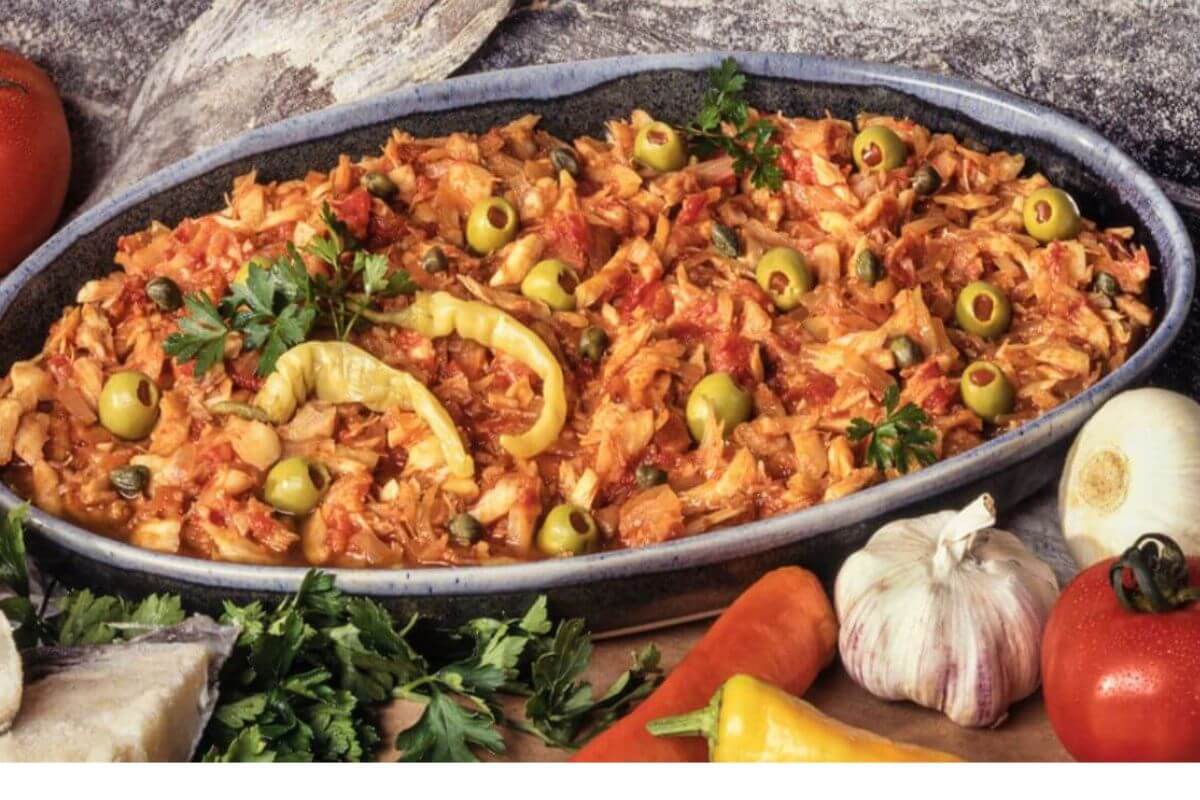
Where to Stay in Cholula for Semana Santa
Here are 3 of our favorite places to stay in Cholula.
San Miguel de Allende, Guanajuato
San Miguel de Allende marks the beginning of the Easter season with the traditional arrival of El Señor de la Columna. The Procession of the El Señor de la Columna is a tradition that is over 200 years old and takes place on the weekend before Palm Sunday.

Believers carry an effigy of Christ from the sanctuary of Atotonilco, walking for hours until they reach San Miguel de Allende. The statue is very old and was crafted from traditional Chichimeca materials including corn stalks, corn starch and powdered orchid bulbs and depicts an exhausted and bloodied Christ leaning against a column for support.
Throughout the journey, local women drape silk scarves across his battered body. Neighbors will open their houses so that the pilgrims can use the bathroom and have some coffee and bread to sustain them. In preparation for the arrival of the procession, the streets of San Miguel de Allende are decorated with alfombras, creating a soft and aromatic path for the worshipers.

The solemn procession begins at midnight, 12 kilometers away in the pueblo of Atotonilco and arrives at Iglesia San Juan de Dios at dawn. San Miguel de Allende is also one of the best places to witness the Burning of Judas (El Quema de Judas) which takes place each year on the Saturday before Easter (Sabado Santo).
Where to Stay in San Miguel de Allende for Easter
Casa de Sierra Nevada by Belmond
San Luis Potosí
While there are upward of 350 cities and towns in Mexico that present some form of processions during the Holy Week, the city of San Luis Potosí is known for its remarkable Procession of Silence. The procession commemorates the Passion of Christ. It is a reenactment of the Via Crucis (Stations of the Cross), with each station marked by a heavy platform with the relevant imagery.
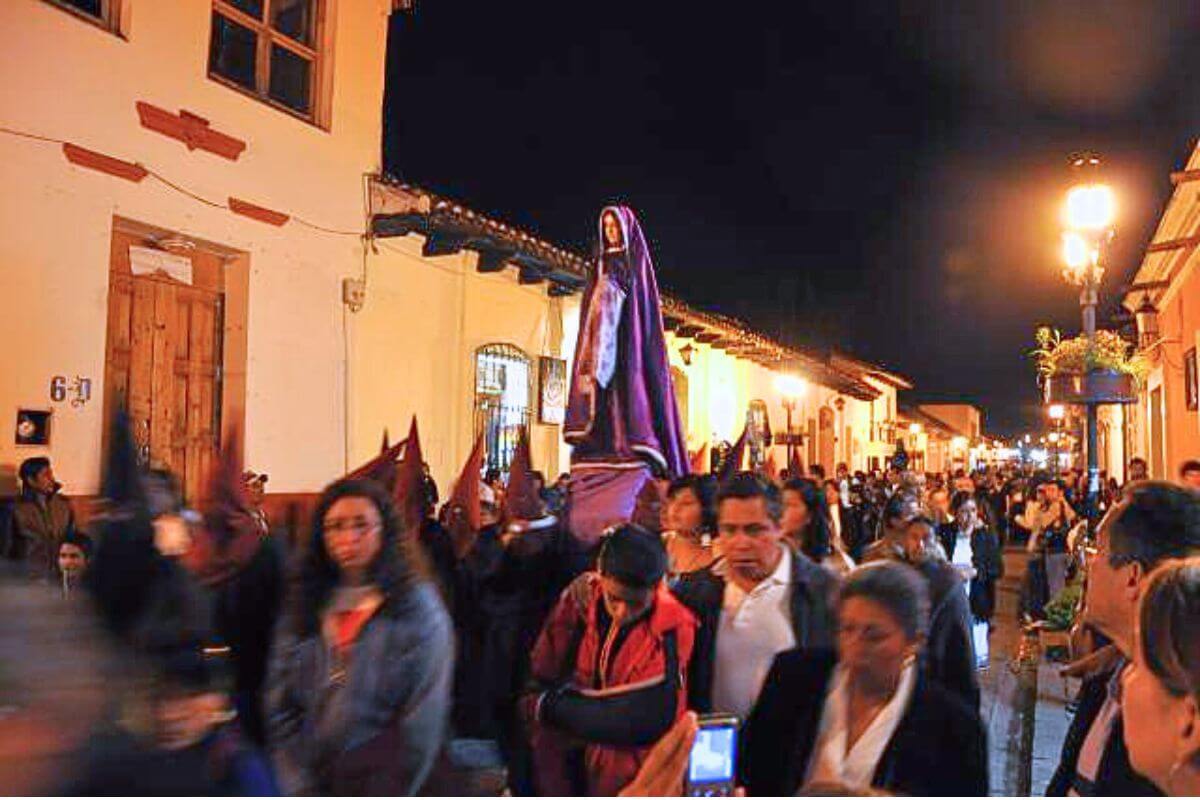
Members of various religious groups carry large platforms with religious images while marching through the historic centro, packed with spectators. The silence is broken only by the sound of drums and the occasional blast of the bugle.
This procession is one of the most important Holy Week observances in Mexico and the most important religious event for the state of San Luis Potosí. This iconic Semana Santa procession takes place every year on Good Friday and attracts over 160,000 visitors to the city from across Mexico and abroad.
Where to Stay in San Luis Potosi for Holy Week
Hotel Museo Palacio de San Agustin
Taxco, Guererro
In the city of Taxco, 10 major processions occur between Palm Sunday and Easter. These are some of the most authentic Via Crucis that you are likely to witness anywhere in Mexico. The “penitents” are members of three devout religious brotherhoods called “cofradías”. They are the Animas (Bent Ones), the Encruzados (the Crossed) and the Flagelantes (Flagellants).
The members show their faith by walking in chains through the streets, flagellating themselves or carrying large religious objects on their backs. All wear black robes, cinched with a horsehair belt, and a hood to hide their identity.
This is an ancient and often bloody tradition that was introduced to Mexico by the Spanish more than 500 years ago. Despite efforts by the Mexican government to curtail the practice, this tradition lives on in places like Taxco.
Where to Stay in Taxco for Easter
William Hotel Boutique De Diseño
Iztapalapa, Mexico City
The Passion Play of Iztapalapa is a celebration held every year during Holy Week in Iztapalapa, a small borough of Mexico City. It is one of the oldest and most elaborate Passion Plays in Mexico and one of the largest in Latin America.

This production of the Via Crucis (The Way of the Cross) involves the coordination of nearly 5000 local Iztapalapa residents who painstakingly reenact scenes related to the last week of Jesus’s life. Devotees known as Nazarenes follow the processions, carrying their own crosses, and wearing real crowns of thorns like Jesus. The devout travel great distances to bear witness to this solemn occasion.
Unlike most Holy Week rituals that were introduced to Mexico by the Spanish, this powerful Passion Play has been presented every year since 1843 after a major cholera epidemic killed off most of the neighborhood’s population. Those who survived expressed their appreciation to Nuestro Señor de la Cuevita (Our Lord of the Little Cave) by honoring him with this reenactment of the last days of Christ.
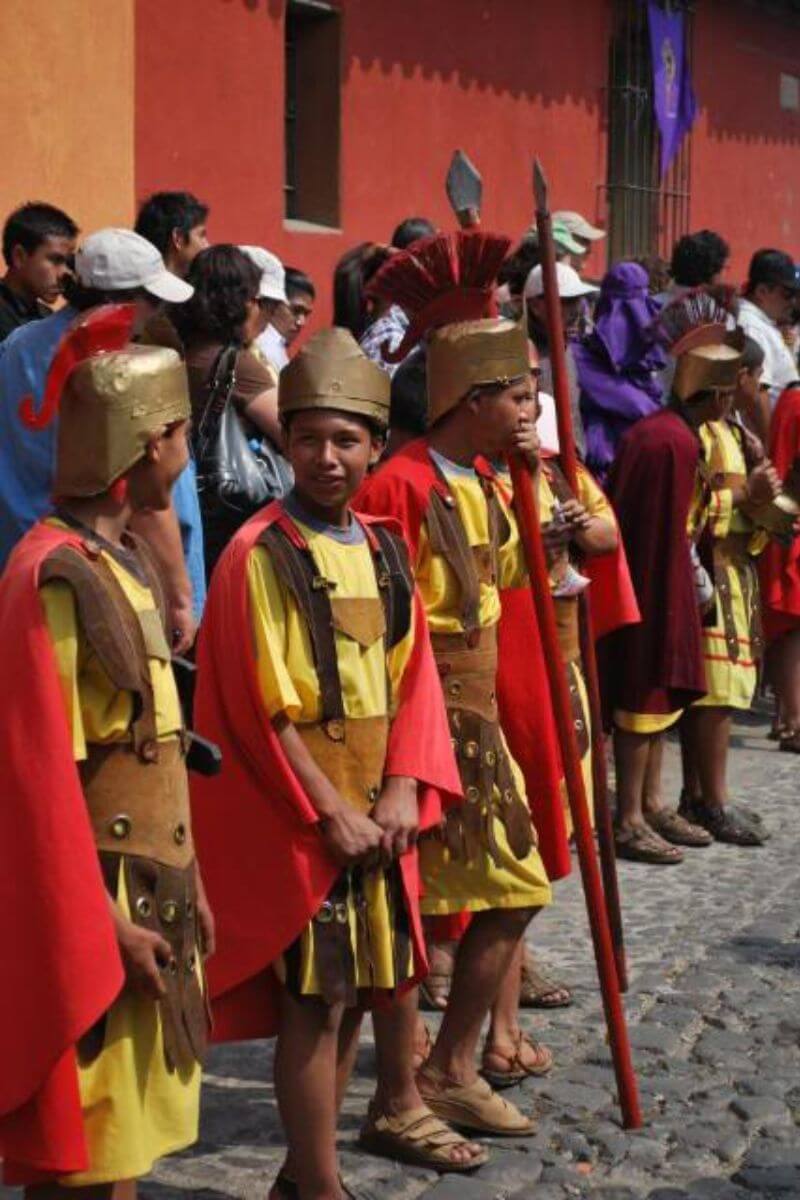
From humble beginnings, the Passion Play of Iztapalapa has grown to become one of the largest religious events in Latin America and now attracts nearly 2 million visitors every year. In 2012, the event was awarded the designation of Cultural and Intangible Heritage in Mexico City and was recently submitted for recognition by UNESCO.
Where to Stay to See the Iztapalapa for the Passion Play
Iztapalapa is located in the southeast quadrant of Mexico City. We recommend that you book accommodations closer to the heart of Mexico City where there will be more options for activities and dining. Iztapalapa can be accessed easily by taxi, Uber, metro line 8 and bus lines 12, 84 and 91.
Gran Hotel Mexico City (Historic Centro)
Agata Boutique Hotel & Spa (Coyoacan)
Casa Condesa Michoacan 113 (Condesa)
Traditional Easter Foods in Mexico
One of the most popular dishes served during Easter in Mexico is Bacalao a La Vizcaína, a salted codfish stew typically served with potatoes, carrots, tomatoes and olives. This dish is a staple during Lent and is often eaten on Good Friday. Bacalao is one of our favorite Holy Week dishes but it is hard to find in restaurants here on the Riviera Maya. If you are invited to try it in someone’s home, do not miss the chance.

Another traditional Easter dish in Mexico is Chiles Rellenos, poblano peppers stuffed with cheese, battered and fried. These are typically served with tomato sauce and rice. Other popular dishes during this time of year include tamales, mole, and various seafood dishes. Another food commonly eaten throughout the holiday season is Empanadas de Vigilia. These empanadas are made with a flour pastry shell and stuffed with tuna and other seafood. They are easy to make and an economical “meat-free” meal to serve during Lent.
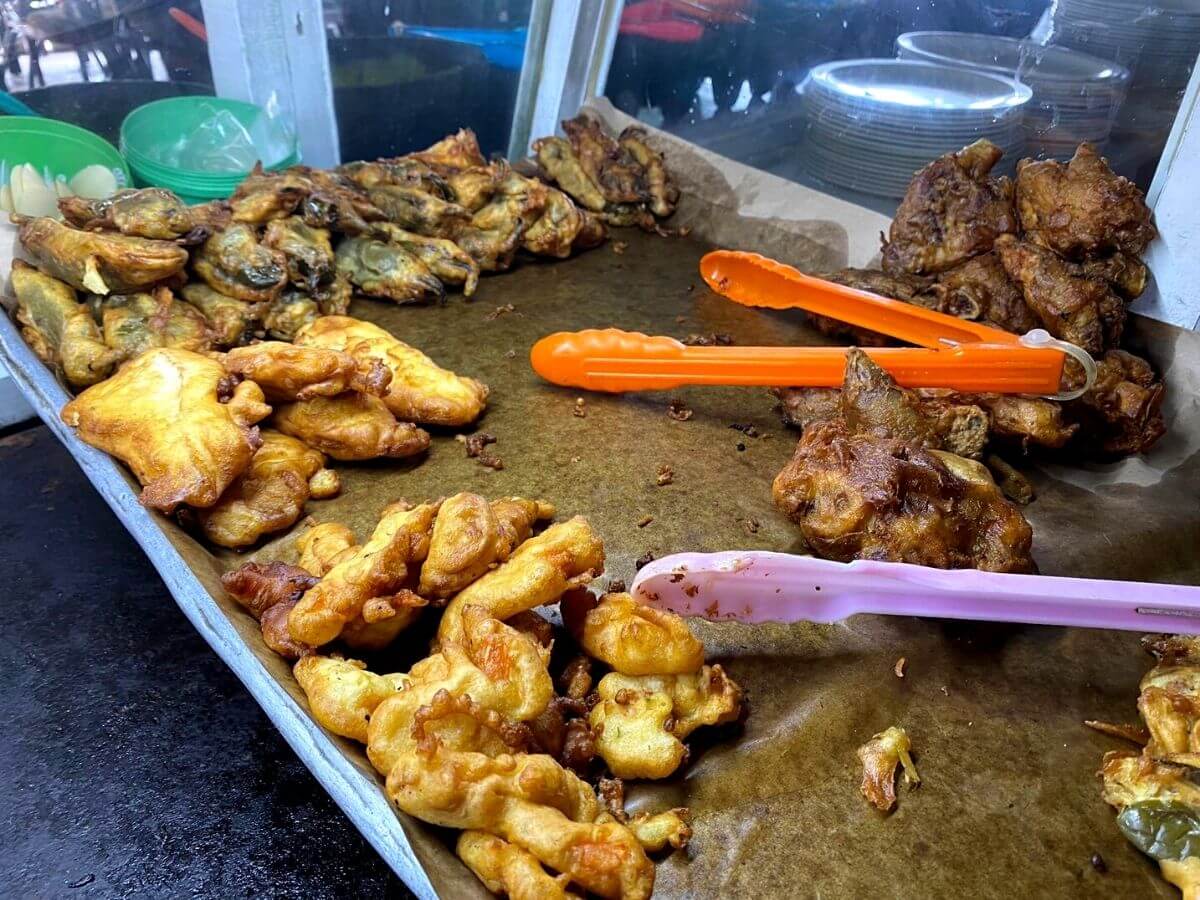
Besides these savory dishes, many sweet treats are enjoyed during Easter in Mexico. One of the most popular desserts is Capirotada, a Mexican bread pudding made with toasted bread, cinnamon, piloncillo, raisins, nuts and cheese. I know it sounds a bit strange but the saltiness of the cheese really makes the dish.

Traveling in Mexico During the Easter Season
Semana Santa, or Holy Week, runs from Palm Sunday to Easter Sunday and is one of the two busiest weeks of the year for domestic travel in Mexico. Traveling in Mexico during the Easter holiday can be challenging.
If your travel plans are set on a beachfront destination such as Puerto Vallarta, Huatulco, Puerto Escondido, Cancun or anywhere along the Riviera Maya, you will be sharing the beach with millions of Mexican nationals who take a break for Semana Santa or the following week, Semana de Pascua.
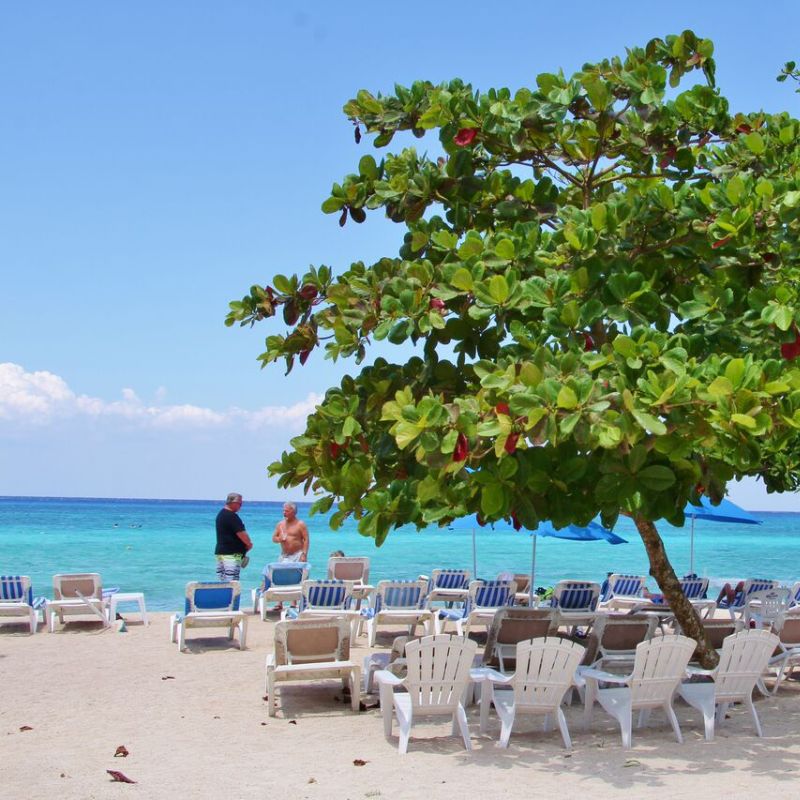
Buy your tickets early. Book your hotel or vacation rental well in advance and make reservations in any restaurants that you have your heart set on. Beach vacation destinations are going to be at maximum capacity during this two-week period. Be prepared to pay high season rates as well.
Likewise, if you are hoping to experience some of the famous Holy Week festivities in cities like Taxco, San Miguel de Allende and Cholula (among others) keep in mind that these are destination events for the millions of devout Catholics in Mexico and abroad. Be sure to make your travel and accommodation plans well in advance. If you can book a hotel in the historic center of these colonial cities you will be well-positioned to see the processions and festivities easily.
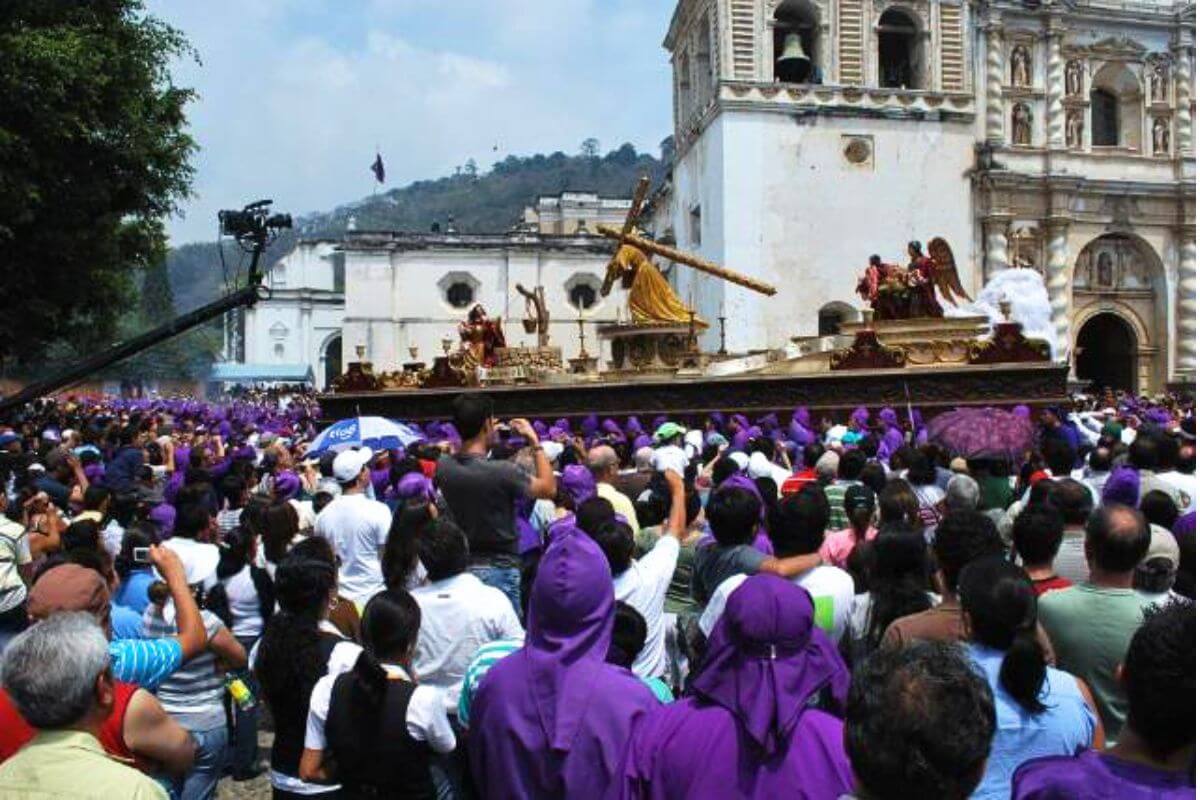
Related Articles
What is Día de la Calendaria and How is it Celebrated in Mexico?
What to Drink in Mexico: 51 Popular Mexican Drinks
